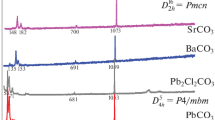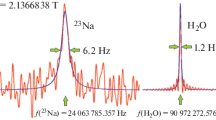Abstract
IN numerous plant substances we have detected strong electron-magnetic resonances from manganese ions (see Fig. 1, for example). The manganese resonance can be immediately recognized by its six-line hyperfine structure resulting from the manganese nuclear interaction (spin 5/2). In all plant materials in which it was found, the multiple spacing was exactly that for manganese ions in aqueous solution (component separations of 95 gauss). Since the manganese multiplet spacing in crystals has been found to depend upon crystalline fields, we conclude that the manganese ions which we have found in plants may be dissolved in their water content.
Similar content being viewed by others
References
Commoner, B., Townsend, J., and Pake, G., Nature, 174, 689 (1954).
Ard, W. B., Shields, H., and Gordy, W., J. Chem. Phys., 23, 1727 (1955).
Ingram, D. J. E., and Bennett, J. E., Discuss. Faraday Soc., April 1955.
Author information
Authors and Affiliations
Rights and permissions
About this article
Cite this article
SHIELDS, H., ARD, W. & GORDY, W. Microwave Detection of Metallic Ions and Organic Radicals in Plant Materials. Nature 177, 984–985 (1956). https://doi.org/10.1038/177984b0
Issue Date:
DOI: https://doi.org/10.1038/177984b0
- Springer Nature Limited
This article is cited by
-
Paramagnetic behaviour of the differentiating reproductive apex of wheat
Biophysik (1971)
-
Manganese Free Radicals in Cobalt-60 Gamma-irradiated Strawberries
Nature (1966)
-
Electron Spin Resonance Investigations of Radiation-Induced Free Radicals in DNA and RNA at Low Temperatures: Effects of Water
Nature (1964)





